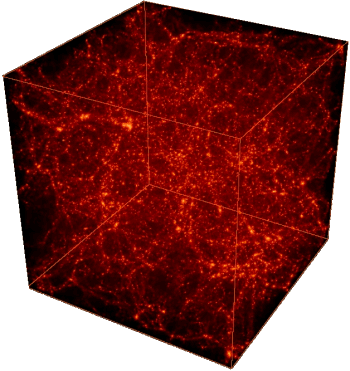Cosmology
|
"Nature uses only the longest threads to weave her patterns, so each small piece
of her fabric reveals the organization of the entire tapestry." ~ Richard Feynman
Anisotropy: This term is frequently used to describe the temperature fluctuations in the Cosmic Microwave Background. The word means not uniform, or not the same. Big Bang Theory: Theory of the creation of the Universe first introduced by George Gamow in the 1940's. Describes the Universe as starting very small, dense, and hot about 15 billion years ago and then expanding into our modern day Universe, and continuing to expand today. Cosmic Microwave Background: This is the electromagnetic radiation "leftover" after the decoupling of photons from matter about 300,000 years after the Big Bang. We study the perturbations or disturbances in the radiation in hopes of one day discovering the ultimate fate of our Universe. Cosmology: The study of the evolution of the Universe and everything in it. Critical Density: The minimum density needed for gravity to overcome the expansion of the Universe and cause it to eventually collapse. Decoupling: Term that describes the event 300,000 years after the Big Bang where the Universe had finally cooled enough so that ordinary matter could form and photons could travel in a free path. During decoupling the Universe goes from opaque to transparent. Event Horizon: Term relating either to the outer perimeter of a black hole, or to how far we can see into the Universe. Because the Universe has a finite age, we cannot observe any part of the Universe that is farther away than its age in light years. As long as the Universe continues to expand at a rate less than the speed of light, our event horizon will continue to get bigger as a function of time. Galaxy: A galaxy is an accumulation of stars and dust and gas that is held together by gravity. The gravitational pull within a galaxy is stronger than the force of the Hubble Expansion, so the elements of a galaxy do not expand away from each other. Galaxies can be spiral-shaped, elliptical, or irregular. Galaxy Cluster: A collection of galaxies that is drawn together by gravity. Galaxy clusters are the largest objects in the Universe that have a gravitational pull strong enough to overcome the Hubble Expansion, and thus galaxies in a cluster to not expand away from each other. Geocentric Universe: A model of the Universe that puts Earth at its center. Heliocentric Universe: A model of the Universe that puts the sun at its center. Hubble Expansion: Used to describe the expansion of the Universe based primarily on the redshifted light of distant galaxies. The relationship between recession velocity and distance is described by Hubble's Law. Homogeneous: When we talk about a homogeneous Universe, we are making the assumption that the Universe is uniform, or has the same large-scale makeup throughout. This means that the matter density of a large-scale region, the amount of galaxies, stars, gas and dust per a certain volume, is pretty much the same anywhere in the Universe. Infinite: And so on, forever. We talk about an infinite Universe in relation to the Steady State Theory, First, steady state theory predicts the Universe to be infinitely big, without limits. Second, Steady State Theory says the Universe is infinitely old, without a beginning. Isotropic: An isotropic Universe has no preferred direction. It behaves the same in every direction. For example, the redshift of distant galaxy clusters looks the same in the direction of Orion as it does in Scorpius. Non-Expanding: A Universe that is not expanding is what we call static. According to Steady State Theory, the Universe is what it always was. Steady state theorists think that what we see is the way the Universe has always looked. A Universe that is expanding would have looked very different at a time billions of years ago. Primordial Soup: The name for the time in the evolution of the Universe where the Universe was too hot to form ordinary matter. The Universe was opaque and glowed due to photons that were being continuously scattered by electrons. Redshift: When a radiating object moves away from us, we observe a redshift in its light, the light waves it emits are getting longer (shifting to the red part of the spectrum). Steady State Theory: Theory of the creation of the Universe that says the Universe has been and always will be like it is today. It assumes that the Universe is uniform, infinite, and not expanding. As a competing theory to the big bang, the steady state theory has been generally discredited because of its inability to explain such things as the cosmic microwave background radiation, the evolution of galaxies, the cosmic redshift, and other observations. |
